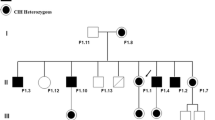Summary
Aspartylglucosaminuria (AGU) is caused by deficient activity of the enzyme aspartylglucosaminidase (AGA). The structural gene for AGA has been assigned to the region 4q21-qter of chromosome 4. We have studied the map position of the AGU locus in relation to other marker loci on the long arm of chromosome 4 using linkage analyses. Restriction fragment length polymorphism alleles for the ADH2, ADH3, EGF, FGα and FGβ loci and blood group antigenes for the MNS locus were determined in a panel of 12 Finnish AGU families. The heterozygous family members were identified by reduced activity of AGA in lymphocytes. Linkage studies were performed using both pairwise and multipoint analyses. Loose linkage of the AGU locus to the FG and MNS loci was observed (\(\hat z\) = 1.16, \(\hat z\) = 1.39, respectively). Multipoint analysis to the fixed map [ADH-(0.03)-EGF-(0.35)-FG-(0.11)-MNS] suggests that the location of the AGU locus is 0.05–0.30 recombination units distal to MNS (\(\hat z\) = 3.03). The order cen-ADH-EGF-FG-MNS-AGU is 35 times more likely than the next best order cen-ADH-EGF-AGU-FG-MNS.
Similar content being viewed by others
References
Aula P, Raivio KO, Autio S (1976) Enzymatic diagnosis and carrier detection of aspartylglucosaminuria using blood samples. Pediatr Res 10:625–629
Aula P, Astrin KH, Francke U, Desnick RJ (1984) Assignment of the structural gene encoding human aspartylglucosaminidase to the long arm of chromosme 4 (4q21–4qter). Am J Hum Genet 36:1215–1224
Aula P, Renlund M, Raivio O, Koskela S-L (1986) Screening of inherited oligosaccharidurias among mentally retarded patients in northern Finland. J Ment Defic Res 30:365–368
Bootsma D, McAlpine P (1979) Report of the committee on the genetic constitution of chromosomes 2, 3, 4 and 5. (5th International Workshop on Human Gene Mapping) Cytogenet Cell Genet 25:21–31
Chitayat D, Nakagawa S, Marion RW, Sachs GS, Hahm SYE, Goldman HS (1988) Aspartylglucosaminuria in a Puerto Rican family: additional features of a panethnic disorder. Am J Med Genet 31:527–532
Chung DW, Que BG, Rixon MW, Mace M, Davie EW (1983) Characterization of complementary deoxyribonucleic acid for the β chain of human fibrinogen. Biochemistry 22:3244–3250
Gehler J, Sewell AC, Becker C, Hartmann J, Spranger J (1981) Clinical and biochemical delineation of aspartyl-glycosaminuria as observed in two members of an Italian family. Helv Paediatr Acta 36:179–189
Hreidarsson S, Thomas GH, Valle DL, Stevenson RE, Taylor H, McCarty J, Coker SB, Green WR (1983) Aspartylglucosaminuria in the United States. Clin Genet 23:427–435
Humphries SE, Imam AMA, Robbins TP, Cook M, Carritt B, Ingle C, Williamson R (1984) The identification of a DNA polymorphism of the a fibrinogen gene, and the regional assignment of the human fibrinogen genes to 4q26-qter. Hum Genet 68:148–153
Isenberg JN, Sharp HL (1975) Aspartylglucosaminuria: psychomotor retardation masquerading as a mucopolysaccharidosis. J Pediatr 86:713–717
Kunkel LM, Smith KD, Boyer SH, Borganonkar DS, Wachtel SS, Miller OJ, Breg WR, Jones HW (1977) Analysis of human Y-chromosome-specific reiterated DNA in chromosome variants. Proc Natl Acad Sci USA 74:1245–1249
Lathrop GM, Lalouel JM, Julier C, Ott J (1984) Strategies for multilocus linkage analysis in humans. Proc Natl Acad Sci USA 81:3443–3446
Morton C, Bell G, Shows T (1985) Epidermal growth factor (EGF) is located at q25–q27 on human chromosome 4. Cytogenet Cell Genet 40:702–703
Murray JC, DeHaven CR, Bell GI (1986) RFLP's for epidermal growth factor (EGF), a single copy sequence at 4q25–4q27. Nucleic Acids Res 14:5117
Murray JC, Buetow KH, Smith M, Carlock L, Chakravarti A, Ferrell RF, Gedamu L, Gilliam C, Shiang R, DeHaven CR (1988) Pairwise linkage analysis of 11 loci on human chromosome 4. Am J Hum Genet 42:490–497
Musumeci S, Salvati A, Schiliro G, Salvo G, Di Dio R, Caprari P (1984) Homozygous NADH-methemoglobin reductase and aspartylglucosaminidase deficiencies in a moderately retarded Sicilian child. Am J Med Genet 19:643–650
Nevanlinna HR (1972) The Finnish population structure. A genetic and genealogical study. Hereditas 71:195–236
Pollitt RJ, Jenner FA, Merskey H (1968) Aspartylglycosaminuria. An inborn error of metabolism associated with mental defect. Lancet II:253–255
Smith M, Duester G, Carlock L, Wasmuth J (1985) Assignment of ADH1, ADH2 and ADH3 genes (class I ADH) to human chromosome 4q21–4q25, through use of DNA probes. (8th Inernational Workshop on Human Gene Mapping) Cytogenet Cell Genet 40:748
Vandenplas S, Wiid I, Grobler-Rabie A, Brebner K, Ricketts M, Wallis G, Bester A, Boyd C, Mathew C (1984) Blot hybridisation analysis of genomic DNA. J Med Genet 21:164–172
Author information
Authors and Affiliations
Rights and permissions
About this article
Cite this article
Grön, K., Aula, P. & Peltonen, L. Linkage of aspartylglucosaminuria (AGU) to marker loci on the long arm of chromosome 4. Hum Genet 85, 233–236 (1990). https://doi.org/10.1007/BF00193202
Received:
Issue Date:
DOI: https://doi.org/10.1007/BF00193202




